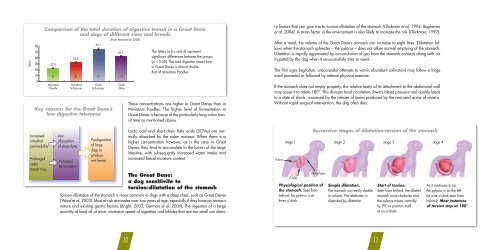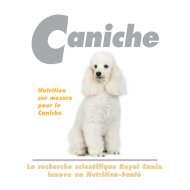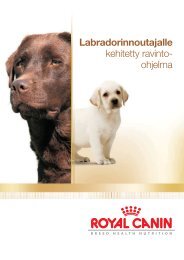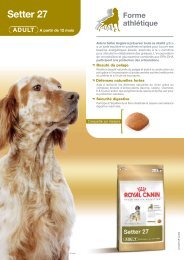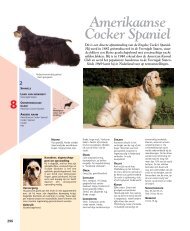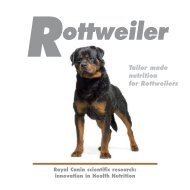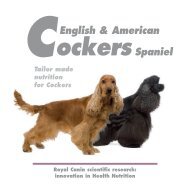The Great Dane - Breed Nutrition - Royal Canin
The Great Dane - Breed Nutrition - Royal Canin
The Great Dane - Breed Nutrition - Royal Canin
Create successful ePaper yourself
Turn your PDF publications into a flip-book with our unique Google optimized e-Paper software.
Hours<br />
60<br />
50<br />
40<br />
30<br />
20<br />
10<br />
0<br />
a b c d<br />
Miniature<br />
Poodle<br />
Standard<br />
Schnauzer<br />
Giant<br />
Schnauzer<br />
Key reasons for the <strong>Great</strong> <strong>Dane</strong>’s<br />
low digestive tolerance<br />
Increased<br />
intestinal<br />
permeability<br />
Prolonged<br />
colon<br />
transit time<br />
Comparison of the total duration of digestive transit in a <strong>Great</strong> <strong>Dane</strong><br />
and dogs of different sizes and breeds<br />
22.9<br />
32.8<br />
Low<br />
absorption<br />
of electrolytes<br />
Increased<br />
fermentation<br />
55.1<br />
Predisposition<br />
of large<br />
dogs to<br />
produce<br />
wet faeces<br />
(From Hernot et al, 2005)<br />
43.2<br />
<strong>Great</strong><br />
<strong>Dane</strong><br />
<strong>The</strong>se concentrations are higher in <strong>Great</strong> <strong>Dane</strong>s than in<br />
Miniature Poodles. <strong>The</strong> higher level of fermentation in<br />
<strong>Great</strong> <strong>Dane</strong>s is because of the particularly long colon transit<br />
time as mentioned above.<br />
Lactic acid and short-chain fatty acids (SCFAs) are normally<br />
absorbed by the colon mucosa. When there is a<br />
higher concentration however, as is the case in <strong>Great</strong><br />
<strong>Dane</strong>s, they tend to accumulate in the lumen of the large<br />
intestine, with subsequently increased water intake and<br />
increased faecal moisture content.<br />
<strong>The</strong> <strong>Great</strong> <strong>Dane</strong>:<br />
a dog sensitivite to<br />
torsion-dilatation of the stomach<br />
Torsion-dilatation of the stomach is more common in dogs with a deep chest, such as <strong>Great</strong> <strong>Dane</strong>s<br />
(Ward et al, 2003). Most at risk are males over two years of age, especially if they have an anxious<br />
nature and existing gastric lesions (Bright, 2003; German et al, 2006). <strong>The</strong> ingestion of a large<br />
quantity of food all at once, excessive speed of ingestion and kibbles that are too small are dieta-<br />
10<br />
<strong>The</strong> letters (a,b,c and d) represent<br />
significant differences between the groups<br />
(p < 0.05). <strong>The</strong> total digestive transit time<br />
in <strong>Great</strong> <strong>Dane</strong>s is almost double<br />
that of Miniature Poodles.<br />
ry factors that can give rise to torsion-dilatation of the stomach (Glickman et al, 1994; Raghavan<br />
et al, 2004). A stress factor in the environment is also likely to increase the risk (Glickman, 1997).<br />
After a meal, the volume of the <strong>Great</strong> <strong>Dane</strong>’s stomach can increase to eight litres. Dilatation follows<br />
when the stomach sphincter – the pylorus – does not allow normal emptying of the stomach.<br />
Dilatation is rapidly aggravated by accumulation of gas from the stomach contents along with air<br />
ingested by the dog when it unsuccessfully tries to vomit.<br />
<strong>The</strong> first signs (agitation, unsuccessful attempts to vomit, abundant salivation) may follow a large<br />
meal preceded or followed by intense physical exercise.<br />
If the stomach does not empty properly, the relative laxity of its attachment to the abdominal wall<br />
may cause it to rotate 180°. This disrupts local circulation, lowers blood pressure and quickly leads<br />
to a state of shock, worsened by the release of toxins produced by the necrosed areas of viscera.<br />
Without rapid surgical intervention, the dog often dies.<br />
Pylorus<br />
Successive stages of dilatation-torsion of the stomach<br />
stage 1 stage 2 stage 3 stage 4<br />
Fundus<br />
Oesophagus<br />
Physiological position of<br />
the stomach. Seen from<br />
behind, the pylorus is at<br />
three o’clock.<br />
Simple dilatation.<br />
<strong>The</strong> stomach can easily double<br />
in volume. <strong>The</strong> abdomen is<br />
distended by dilatation.<br />
11<br />
Start of torsion.<br />
Seen from behind, the dilated<br />
stomach turns clockwise and<br />
the pylorus moves ventrally<br />
by 90° to position itself<br />
at six o’clock.<br />
As it continues to tip,<br />
the pylorus is on the left<br />
(at nine o’clock seen from<br />
behind). Most instances<br />
of torsion stop at 180°.


